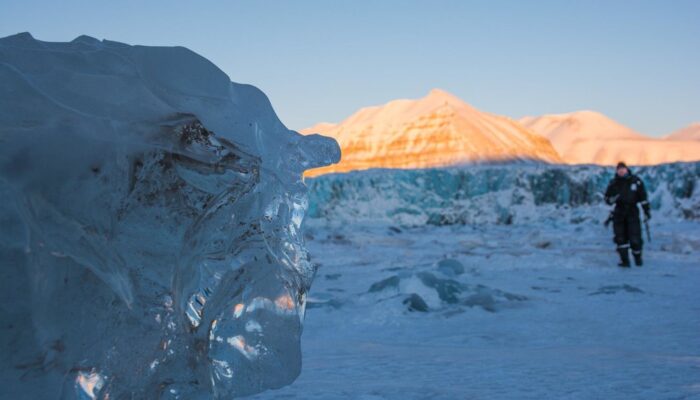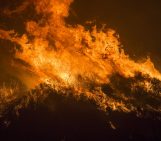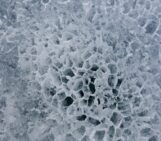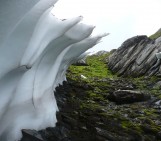
These ethereal, twisted ice sculptures litter the frozen shoreline of Tempelfjorden, Svalbard, giving the landscape an otherworldly feel and creating a contrast with the towering ice cliff of the glacier and the mountains behind. They are natural flotsam, the scoured remnants of icebergs calved from the Tunabreen glacier, washed up on the shoreline.
These icebergs were calved from the Tunabreen glacier, which flows into Tempelfjorden from its source at the Lomonosovfonna ice cap. Tunabreen is a surge-type glacier, which means that it periodically switches between long periods of slow, stable flow to short-lived periods of very fast flow during which it advances. Tunabreen has historically surged approximately every 35 to 40 years, and its calving front advanced more than 2 kilometres during a surge in 2004.
Tunabreen is one of the glaciers monitored by the Calving Rates and Impact on Sea Level (CRIOS) project, an international initiative that involves several institutions. The glacier tends to slow during the winter months when there is less meltwater available to lubricate the sliding of ice over bedrock. Glaciologists were caught by surprise, therefore, when in late 2016 the glacier was observed to accelerate to speeds in excess of 3 m/day from the more usual 0.4 m/day. This acceleration began at the glacier terminus and spread up to 7km upstream over the following months. Tunabreen appeared to be surging decades earlier than expected!
The causes of this change in the glacier’s behaviour are not certain. However, the onset of this acceleration followed an unusually warm and wet autumn. Sea ice, which usually acts to oppose the flow by applying a resistive pressure against the calving front, also failed to form in Tempelfjorden over the winter. Both of these factors likely contributed. As a result of the flow acceleration, the surface of the glacier has become heavily crevassed, posing a hazard to travellers and glaciologists hoping to cross it!
I was fortunate to be able to visit Tunabreen in March 2017, as part of a glaciology course taught at UNIS, the University Centre in Svalbard. The view of the glacier’s 100ft high calving front framed by the mountains in the background is spectacular, and the trip by snowmobile was a fantastic daytrip. The surge continued throughout 2017 and early 2018, with the calving front advancing by more than a kilometre during that period. Since the summer of 2018, flow velocities have been decreasing, so it appears that the surge may have come to an end. This episode illustrates that there is still much we have to learn about the dynamics of surge-type glaciers, and that they can still take us by surprise!
Matt Trevers, PhD Researcher, Centre for Polar Observation and Modelling, University of Bristol
Further reading
Tunabreen may be surging decades earlier than expected (The University Centre in Svalbard)
What is going on at Tunabreen? (Penny How)
The recent surge of Tunabreen, Svalbard (Adrian’s glacier gallery)
Imaggeo is the EGU’s online open access geosciences image repository. All geoscientists (and others) can submit their photographs and videos to this repository and, since it is open access, these images can be used for free by scientists for their presentations or publications, by educators and the general public, and some images can even be used freely for commercial purposes. Photographers also retain full rights of use, as Imaggeo images are licensed and distributed by the EGU under a Creative Commons licence. Submit your photos at http://imaggeo.egu.eu/upload/.




